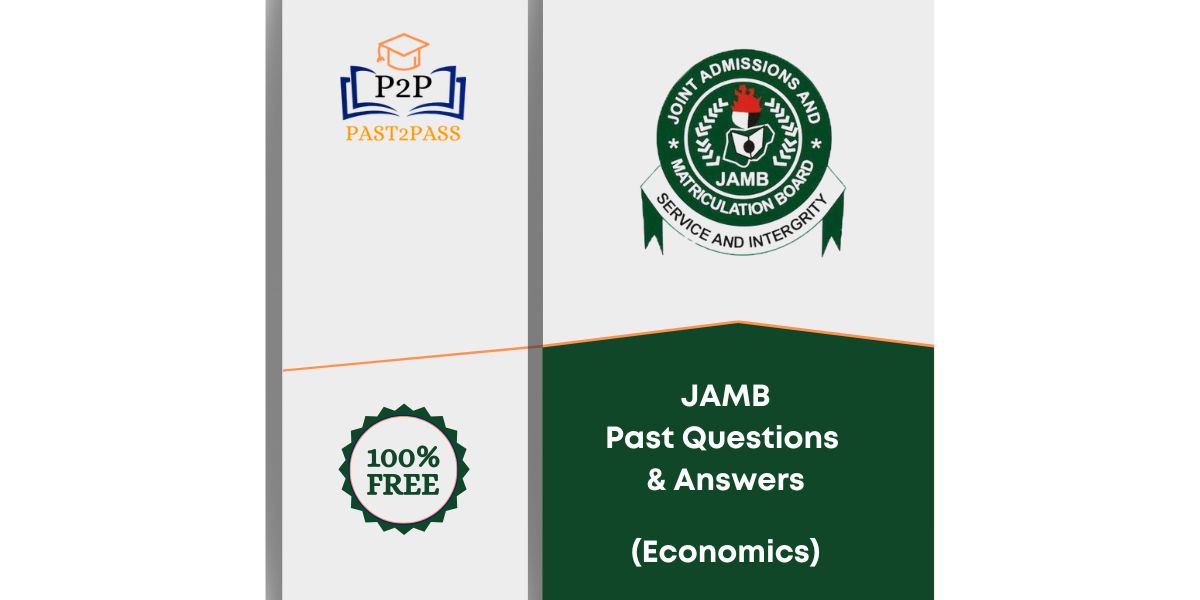Message us on Twitter; we would love to connect! Follow @Past2Pass
— Past2Pass - P2P (@Past2Pass) September 8, 2025
Practice Economics Jamb Question and Answer to prepare for the JAMB exams ahead. The download is free and in PDF format.
Working through these past questions and answers is a great way to boost your confidence and increase your chances of success.
The Joint Admissions and Matriculation Board (JAMB) exam consists of 180 questions, with 40 questions dedicated to the Economics. It’s important to study past questions for guidance to pass the exam.
Economics JAMB Past Question
We have created 30 questions for you to practice. These questions have been selected from previous use of economics jamb questions from year 1983 – 2018.
You can proceed directly to download the JAMB past questions and answers below for free.ns and answers below for free.
1) What is the primary function of money?
A. Store of value
B. Medium of exchange
C. Unit of account
D. Standard of deferred payment
ANS: B
2) In Economics, the term “opportunity cost” refers to:
A. The cost of producing goods
B. The next best alternative forgone
C. The total money spent on production
D. The cost of raw materials
ANS: B
3) Which of the following is NOT a factor of production?
A. Land
B. Labour
C. Money
D. Capital
ANS: C
4) A demand curve slopes downward because:
A. Prices increase as demand falls
B. Consumers buy more at lower prices
C. Supply affects demand
D. Government regulates prices
ANS: B
5) Inflation is best described as:
A. A fall in the general price level
B. A rise in the general price level
C. A stable price level
D. A decrease in money supply
ANS: B
6) Which of the following is a characteristic of a monopoly?
A. Many sellers
B. Homogeneous products
C. Single seller
D. Free entry and exit
ANS: C
7) The Central Bank’s role includes all EXCEPT:
A. Issuing currency
B. Accepting deposits from the public
C. Controlling inflation
D. Implementing monetary policy
ANS: B
8) GDP stands for:
A. Gross Domestic Product
B. General Demand Price
C. Government Development Plan
D. Gross Development Profit
ANS: A
9) A major cause of unemployment in Nigeria is:
A. High population growth
B. Excess job opportunities
C. Low demand for goods
D. High wages
ANS: A
10) Elasticity of demand measures the:
A. Responsiveness of demand to price changes
B. Total revenue from sales
C. Cost of production
D. Government tax policies
ANS: A

11) Which is a direct tax?
A. VAT
B. Excise duty
C. Personal income tax
D. Customs duty
ANS: C
12) The law of diminishing returns applies to:
A. Only agriculture
B. Only manufacturing
C. All sectors (short run)
D. Government projects
ANS: C
13) A budget deficit occurs when:
A. Revenue > Expenditure
B. Expenditure > Revenue
C. Taxes are high
D. Exports > Imports
ANS: B
14) The World Bank primarily provides:
A. Trade regulations
B. Development loans
C. Exchange rate control
D. Currency printing
ANS: B
15) The “invisible hand” concept was coined by:
A. Karl Marx
B. John Keynes
C. Adam Smith
D. David Ricardo
ANS: C
16) Which is a feature of perfect competition?
A. Single seller
B. Price discrimination
C. Free entry/exit
D. Unique products
ANS: C
17) Fiscal policy is implemented by:
A. Central Bank
B. Commercial Banks
C. Government
D. IMF
ANS: C
18) A tariff is a tax on:
A. Local goods
B. Exported goods
C. Imported goods
D. Income
ANS: C
19) Which organization regulates international trade?
A. IMF
B. WTO
C. UN
D. OPEC
ANS: B
20) An example of a renewable resource is:
A. Crude oil
B. Solar energy
C. Gold
D. Natural gas
ANS: B
21) The largest share of Nigeria’s GDP comes from:
A. Agriculture
B. Oil sector
C. Manufacturing
D. Services
ANS: B
22) A rise in interest rates will likely:
A. Increase borrowing
B. Reduce savings
C. Decrease investment
D. Boost inflation
ANS: C
23) Which is a capital market instrument?
A. Treasury bills
B. Stocks
C. Bank loans
D. Credit cards
ANS: B
24) The Lorenz Curve measures:
A. GDP growth
B. Income inequality
C. Unemployment rate
D. Inflation rate
ANS: B
25) An example of a regressive tax is:
A. Income tax
B. VAT
C. Corporate tax
D. Property tax
ANS: B
26) The law of comparative advantage is associated with:
A. Adam Smith
B. David Ricardo
C. Thomas Malthus
D. John Keynes
ANS: B
27) A major goal of ECOWAS is to promote:
A. Military alliances
B. Economic integration
C. Cultural isolation
D. Political conflicts
ANS: B
28) Which is NOT a function of money?
A. Medium of exchange
B. Store of value
C. Measure of utility
D. Unit of account
ANS: C
29) Cost-push inflation is caused by:
A. High demand
B. Rising production costs
C. Excess money supply
D. Low taxes
ANS: B
30) The “terms of trade” refers to the ratio of:
A. Imports to GDP
B. Exports to imports
C. Export prices to import prices
D. Savings to investment
ANS: C
Economics Jamb Past Questions and Answers PDF Download
Click the button below to Download Free PDF of Economic Jamb Past Questions and Answers.
Wishing you good luck!









